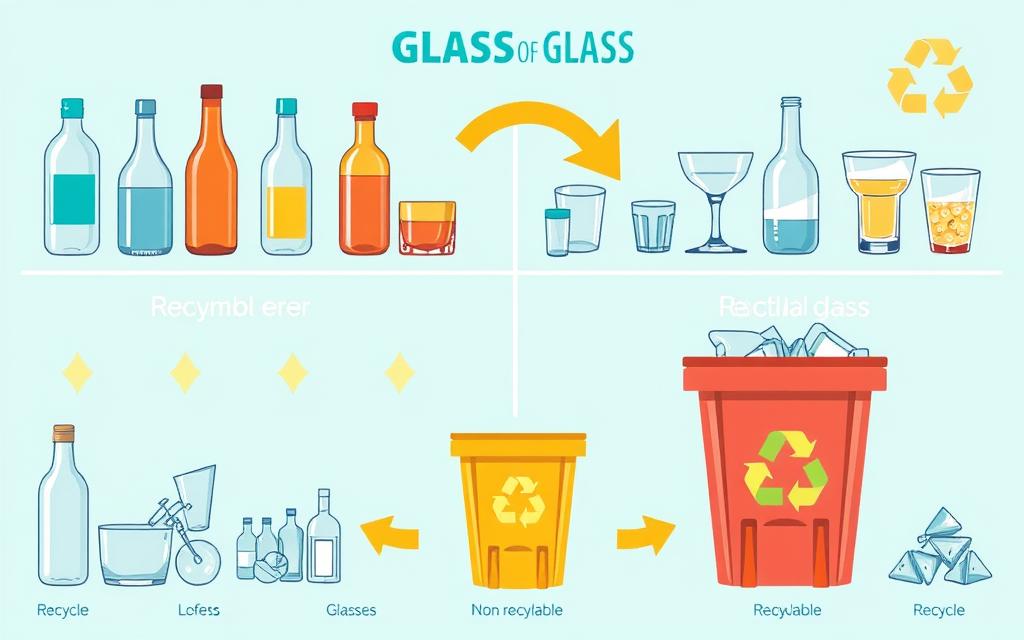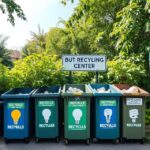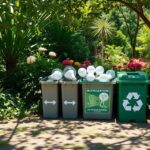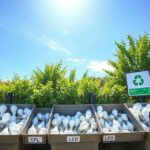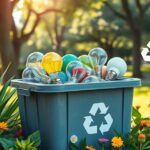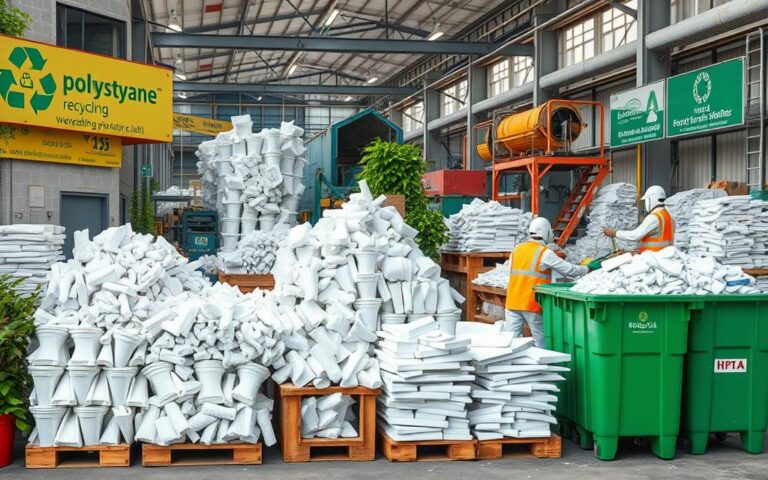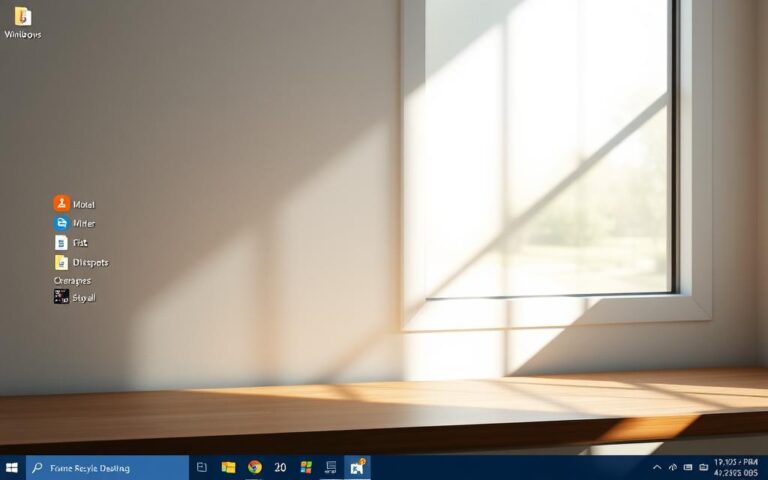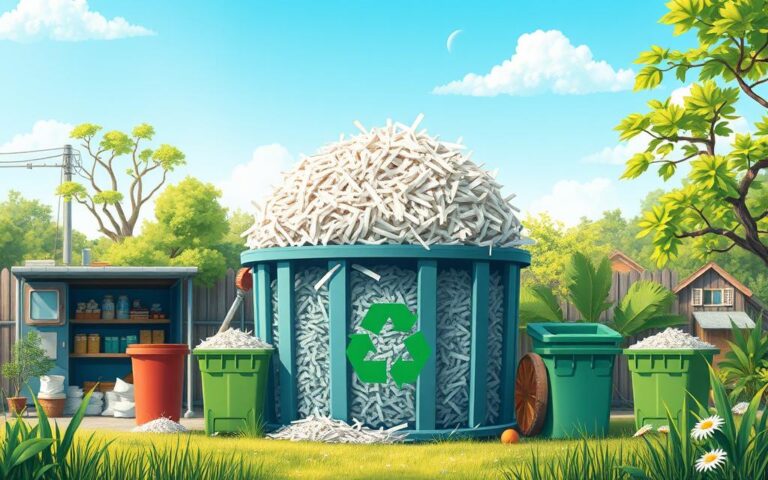Can Glassware Be Recycled? Proper Disposal Guide
Today, knowing how to recycle glass is vital for a green lifestyle. It helps cut down waste and saves precious natural resources. Glass bottles use about 52% recycled materials. More shops now pick glass that can be recycled over and over to be eco-friendly.
We’ll show you if your glass items can be recycled and how to get rid of them greenly. In Europe, glass recycling is doing great, with an 80.1% success rate. This clearly shows recycling glass is key for our Earth.
But, some glass pieces can’t be recycled. This includes nail varnish bottles, Pyrex, and light bulbs. They must be thrown away the right way. Here, we tackle your glass recycling questions and share top tips for doing it well.
Understanding Glass Recycling
Glass recycling is key for a sustainable future. It saves energy and lessens the environmental harm from making glass. When we recycle glass, we see how it helps both people and the planet.
Why Recycling Glass is Important
Recycling glass is vital because it can be recycled forever. Compared to plastic, it’s a better choice. The benefits of glass recycling are vast. For each ton of glass recycled, over a ton of natural resources are saved. This includes sand, soda ash, and limestone.
Recycling glass also cuts carbon dioxide emissions significantly. For every six tons of glass recycled, a ton of CO2 is prevented from polluting the air. Also, for every 10% increase in recycled glass used in production, energy costs drop by about 2-3%.
In America, only around one-third of glass waste is recycled. This is much lower than in Europe, where the rate exceeds 90%. The US struggles with contamination rates between 50% to 60%. This shows the need for better systems and community action to improve recycling. It’s also worth noting that recycling glass creates jobs – over eight jobs per 1,000 tons of glass recycled.
How Glass Recycling Works
The recycling process has several steps: collecting, cleaning, sorting, and crushing glass into cullet. This cullet then goes to manufacturers to make new glass items. Efficient materials recovery facilities (MRFs) manage these steps, which encourages people to recycle more, reducing waste in landfills.
Recycled glass isn’t just for making new containers. It can become insulation, ceramics, and construction aggregate. By understanding all uses of recycled glass, we can support greener practices and change how we manage waste in our areas.
| Statistic | Value |
|---|---|
| Container glass recycling rate in the US | 37% |
| Container glass recycling rate in Europe | 74% |
| Natural resources saved per ton of recycled glass | More than 1 ton |
| Carbon dioxide emissions reduced per ton of glass recycled | 315 kg |
| Job creation per 1,000 tons of glass recycled | 8 jobs |
Can Glassware Be Recycled?
Knowing which glass items can be recycled is key to good waste management. Following glass recycling rules makes sure recyclable glass is processed right and reduces environmental harm.
Types of Glassware That Can Be Recycled
Many glass items we use daily, like those for food and drinks, can be recycled. This includes:
- Glass soda and beer bottles
- Wine bottles
- Glass food containers like jars
These glass items play a big role in recycling efforts. Bottle and jar glass can be recycled over and over. And with glass demand rising by six percent yearly, recycling is more important than ever.
Non-Recyclable Glassware
However, not all glass items can be recycled. Examples of non-recyclable glass include:
- Glass cookware such as Pyrex
- Glass decorations
- Drinking glasses
- Mirrors
- Lightbulbs
When non-recyclable glass mixes with recyclable types, it lowers the quality of recycled material. Even though broken glass is recyclable, don’t put it in the bin for safety reasons. Wrap it carefully and put it in the trash. Following these steps makes recycling more effective and increases the use of recycled materials.

Preparing Glassware for Recycling
For effective glass recycling, preparing the glass properly is key. This means cleaning thoroughly and taking off any parts that aren’t glass. These actions improve the recycled material’s quality and make recycling more efficient.
Cleansing Glass Containers
Before recycling, it’s vital to clean glass containers. Rinsing out any leftovers helps avoid contamination and bad smells in the bin. Just a quick wash with water is enough to remove food or liquids that might cause problems during recycling. Recycling plants prefer clean glass because it leads to better-quality recycled products.
Removing Labels and Lids
It’s crucial to remove labels from glass before recycling. This step makes recycling easier by reducing emissions during the process. Even though labels often burn away, taking them off saves energy and speeds up recycling. Also, take off any lids that aren’t made of glass, as they can’t be recycled together with the glass. Preparing everything correctly makes recycling smoother and more eco-friendly.
Methods of Glass Recycling
Glass recycling is crucial for waste reduction and resource conservation. It lets us choose how to recycle glass items wisely. There are two primary methods: curbside recycling and drop-off recycling.
Curbside Recycling Pick-Up
In some places, you can recycle glass right from your doorstep. Curbside glass recycling means you put your clean glass in special bins. It’s easy and helps the community collect recyclables fast. However, it’s not available everywhere, as some areas don’t include glass in their curbside collection.
When it is an option, it makes recycling simpler for everyone.
Glass Recycling Drop-Off Locations
If curbside recycling isn’t an option, try glass drop-off recycling. You can take glass to designated spots yourself. Websites like GlassRecycles.org show you where to go. Checking with local centres can also guide you to proper disposal places.
Using these centres is key to ensuring glass doesn’t just get thrown away. It helps keep our planet greener.
Alternative Disposal Methods for Non-Recyclable Glassware
Recycling glass is wise, but not all glass fits the recycling bin. For those items, finding alternative disposal methods is key. They help cut down on waste and give these items a second chance. Consider donating your glassware or finding creative ways to repurpose it.
Donation and Reuse Opportunities
Usable glassware can greatly aid others if donated. Many organisations warmly welcome these donations. Look to your local thrift shops or charities to pass on your glass items. Doing so not only prolongs the life of these products but also minimises waste significantly.
Creative Upcycling Ideas
Upcycling non-recyclable glass opens up a world of creativity. This could mean turning jars into planters or candle holders. You could even try:
- Turning them into chic storage options
- Making personalised gifts from jars
- Creating garden decorations from bottles
By upcycling, you prevent waste and engage in a creative process. Every project makes your space more personal while promoting eco-friendly practices.
| Type of Glass | Option | Organisation |
|---|---|---|
| Glass Containers | Donation | Thrift Shops |
| Glass Mirrors | Donation | Charitable Organisations |
| Windows/Panes | Donation | Habitat for Humanity |
| Miscellaneous Glass Items | Upcycling Projects | DIY Enthusiasts |
Conclusion
Understanding the process of glass recycling is key to promoting eco-friendly ways of throwing things away. Recycling glass greatly reduces pollution and saves important resources. For example, using recycled materials to make glass lowers air pollution by 20% and water pollution by 50%.
We also save a lot of glass from ending up in landfills by sorting and preparing it for recycling. This action saves precious materials like sand, soda ash, and limestone.
Knowing what glass items can be recycled and cleaning them well leads to a better final product. Finding other ways to dispose of glass, like upcycling or donating, is also important. Whether through kerbside recycle schemes or local glass bottle banks, every effort helps create a greener future.
By adopting better recycling habits in our everyday lives, we can increase our positive effect on the earth. Every little step helps make our planet healthier. It pushes us towards a way of life that’s kind to our earth and vital for a sustainable future.
FAQ
Can all types of glass be recycled?
No, not all glass products are recyclable. Food packaging glass like jars and bottles can be recycled. But, glass cookware, mirrors, and lightbulbs usually can’t be.
What happens to glass once it’s recycled?
After collection, glass gets cleaned and sorted, then crushed into cullet. Manufacturers buy this cullet to make new glass items, cutting down on raw materials.
Why is it necessary to rinse glass containers before recycling?
Rinsing glass containers clears away contaminants and stops bad smells. It keeps the recycling process tidy and makes the recycled materials better.
How can I find local glass recycling services?
Look for your local council’s curbside recycling or visit GlassRecycles.org. They can guide you to glass recycling spots close to you.
What can I do with non-recyclable glass items?
If non-recyclable glass is still good, donate it to charity shops or thrift stores. Or, turn it into art or decor for your home.
Is it eco-friendly to throw glass in the regular bin?
Throwing glass in the regular bin is bad for the environment. Glass doesn’t break down in landfills. So, recycle or repurpose it to help our planet and save resources.
Why is glass recycling considered beneficial for the environment?
Recycling glass saves natural resources, cuts carbon emissions, and uses less energy. It’s key to keeping our environment healthy.
Do I need to remove lids from glass jars before recycling?
Yes, take non-glass lids off before recycling. This makes the recycling smoother and ensures the materials are of high quality.

